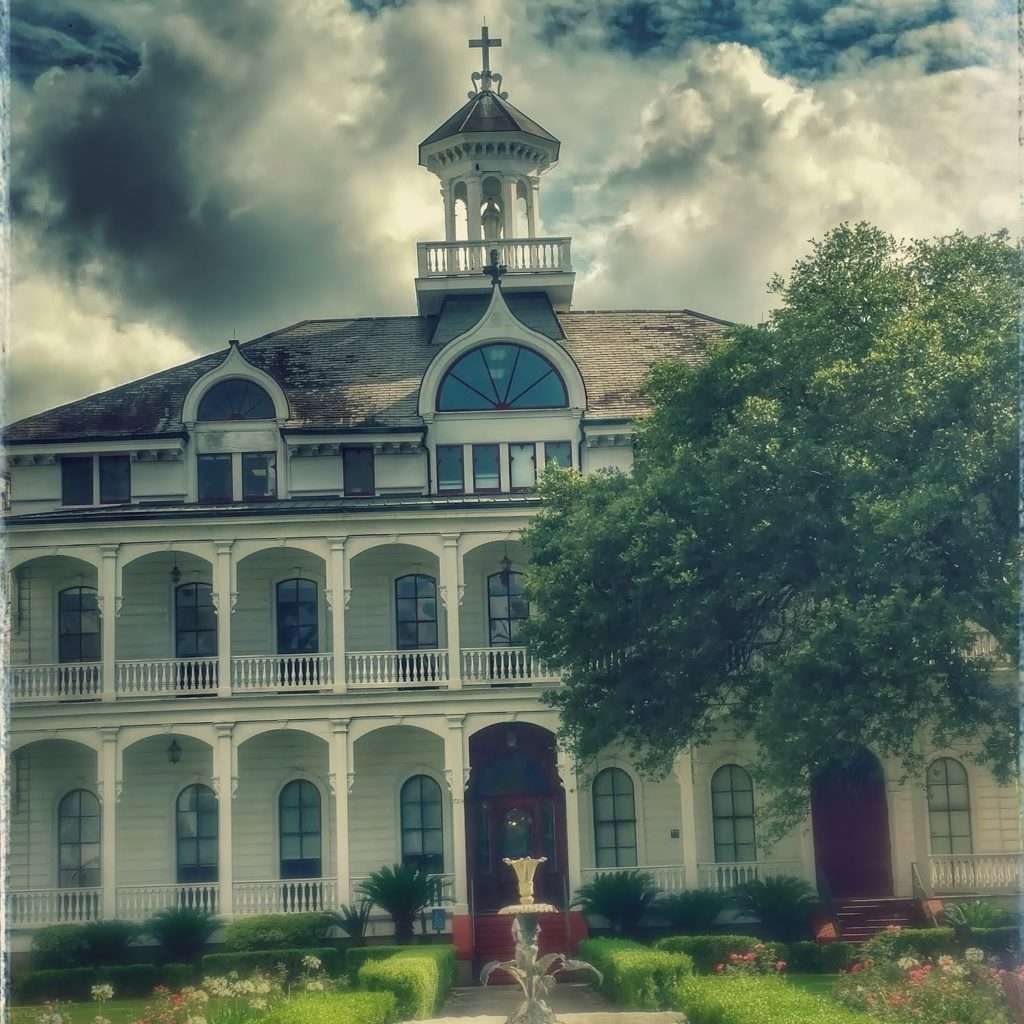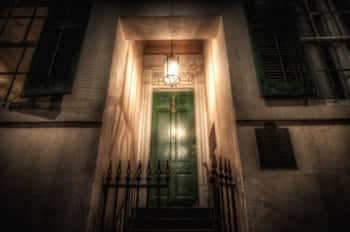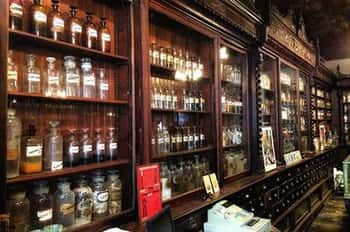6363 St Charles Ave, New Orleans, Louisiana 70118
It’s a truth universally acknowledged that many public buildings tend to have ghosts hanging around. Whether it’s a female spirit who sits on a swing in the park, or the rather rambunctious specter playing pranks on a theatre’s guests, ghosts commonly camp out in public places.
One other place they tend to haunt? Schools.

Here in New Orleans, there is one particular university which has a multitude of ghost stories. What am I talking about? New Orleans’ Loyola University. When one of your buildings just so happens to have had a floor dedicated to being a morgue, you know there are a few spirits still lingering around.
And since Loyola University is this author's alma mater, this article is personal.
Loyola College opened in 1904, in which classes were initially held behind the first Holy Name of Jesus Church on the prosperous St. Charles Avenue. The first of Loyola’s buildings were constructed between 1907 and 1910—the stunningly Gothic-influenced Marquette Hall.
Loyola University officially earned its collegiate chapter on July 10, 1912.
Less than a year late in 1913, Miss Kate McDermott, the sister to the Hibernia Bank Director, donated $150,000 to the funding of a new church. She also made Loyola University heir to her entire estate. Holy Name of Jesus Church was thus put on wheels and rolled sixty feet over, in which the new church was soon after constructed.
Within five years, the College of Arts & Sciences, the School of Law, the School of Dentistry and the College of Pharmacy had opened. In 1922, the WWL Radio, which was established at Loyola, began holding the first radio broadcasts in all of the Deep South. Broadcasts were made from Marquette Hall, but on Sundays they were done at Holy Name of Jesus Church.
Over the years, Loyola University New Orleans has changed and grown. Its football team was dissolved in the 1930s, which led to a University T-shirt being created in 2008: “Undefeated since the 1930s.” The acclaimed School of Music was added, and then the Colleges of Pharmacy and School of Dentistry closed in the mid-twentieth century.
Hurricane Katrina caused a deflation in school applicants, and the numbers did not resume to pre-Katrina rates until about 2012.
Through it all, Loyola University New Orleans has remained one of the best schools in the Deep South, both for its Jesuit education and its dedication to providing students with the tools they need to succeed (and I’m not just saying that because I’m an alumni).
But as famous as the school might be for its academics, its ghostly stories and hauntings are a much-larger kept secret among the student body, administration and the university’s employees.
Until now.
Marquette Hall is Loyola’s own castle, complete with dark brick, Gothic arches and turrets. At night, Marquette Hall looks like a Disney fairytale, illuminated against the black sky.
The Hall was named in honor of Father Jacques Marquette, who was a French born Jesuit explorer in the New World. When Marquette Hall was completed in 1910, it remained Loyola’s prominent building until Bobet Hall was erected next-door in the 1920s.
For the most part, Marquette Hall was like any other early university building. It was a package of administration offices, classrooms and an entire floor dedicated to the university’s first library.
Where Marquette Hall took a creepy turn was on its fourth and fifth floors. From 1916 to 1966, the fifth floor was strictly dedicated to students enrolled in anatomy classes . . . and the cadavers that they dissected in Room 501.
The rest of that floor was the University’s very own morgue for the dentistry school.
Since the building’s elevator did not ascend to the fifth floor, Loyola installed a crane to the back of Marquette Hall, as well as an external winch on the fifth floor, so that corpses could be hauled up. (Because there is nothing like heading to class only to realize that you are competing for the stairwell with a dead body).
According to former officers of the Loyola University Police Department (LUPD), that external winch still exists. It would have been used specifically to hoist corpses up from the ground level with chains around the ankles, before the body was raised to the metal walkway on the fifth floor and onto a gurney. From there, workers could wheel the gurney into the building.
While Marquette Hall no longer uses the top two floors as either a dissection area or a morgue, their ambience seems to still be imprinted from days gone by. Students have sworn to feel abrupt temperature changes, from a chill settling over their shoulders to sweat prickling the forehead from the sudden heat.
Doors open and slam shut by unseen forces, and even the lights have been known to flicker and fade to black.
Some have even claimed to see spirits roaming the hallways . . . or even outside of the windows. Back during the school’s morgue days, students often learned the hard way when a body was being hoisted: “If you were sitting by the window in class on the fourth floor and you heard the pulleys creaking, you knew they were bringing a body up [ . . . ] Sometimes the stretcher would tilt and a bare foot would stick out from underneath the sheet” (The Maroon Newspaper, 2002).
Today students and staff swear that when the windows are open, they can still hear the eerie cranking of the pulley system, even though no cadavers have been brought into Marquette Hall in over fifty years.
“The devil has no power per se. But man’s selfishness has taken creation off on a tangent. Whenever man moves on a tangent off the course of God’s providence, we step into the deep, the unchartered, the chaotic. And that’s when the devil appears.” — Reverend Joseph McGill, Maroon Vol. 50 No. 15, 1974, Loyola University New Orleans
For centuries, Vatican City has had a separate unit of the Church dedicated strictly to evicting the Devil from the sanctity of human life. Sometimes the “Devil” came in the form of religions not approved by the Church (i.e. the Albigensian Crusade in the 13th century).
By 1891, with the release of the Ouija board, the possibility that the average person could use a board game to connect with the dead became a reality. Less than a century later there was the movie premiere of The Exorcist, which forever changed horror movies.
But in 1968, Loyola University New Orleans had its own exorcism.
In a 1974 article written for the university’s newspaper, The Maroon, an investigation began to prove that an exorcism had occurred in one of the school’s dorms, Buddig Hall. The bizarre activity began, naturally, with a Ouija Board.
Two 18-year old girls living in Room 813, Marie and Brenda, frequently broke out their Ouija Board. Sometimes, although not always, the girls from Room 812 joined in as well. They came into contact with what they labeled as an “evil spirit,” who wanted to possess Marie. On other nights, it was a spirit named Hazel who made herself known to the girls.
According to the girls, Hazel was a Creole from New Orleans “whose husband died in prison for a crime she committed.” Hazel even gave a date to validate her claims. On one night, the girls had decamped to their friend Neil’s room (who lived in the adjacent Biever Hall) to play with the Ouija Board.
Apparently Neil laughed at Hazel, to which the spirit replied through the board: “Cut stomach. Kill Neil.”
Whether it was pure coincidence or the act of a malevolent spirit, Neil feinted in the cafeteria the next day and was rushed to the hospital—where he was then diagnosed with appendicitis.
Instead of striking the fear of God into the girls, they were all determined to connect with the dead even more after that. They allegedly met Satan. Dorothea, who had not been interested in the board game, shuffled the girls into a meeting with Father Cohen of the Campus Ministry. The priest made them promise to stop messing with the Ouija board lest they truly spark something evil into action—the girls agreed.
Their promise barely lasted the night.

On one dark night in Room 813, Marie and Brenda were awakened by the sound of furniture scraping over the ground. A poster went flying off the wall and across the room. All of the objects on their shelves had been completely rearranged. They panicked and called Father Cohen at 3:30AM.
He arrived at Buddig Hall later that morning, allowed himself to be escorted up to Room 813, and performed the exorcism. According to the girls, “There were six of us who formed two lines on each side of him. He said prayers [in] Latin and sprinkled holy water on our beds and throughout the suite. We all said the ‘Our Father.’”
The author of the article, Vicki Salloum, questioned various members of the Campus Ministry. Rev. Louis Lambert, the then-Vice Provincial but also a demonologist, said that there was no way to derive from the strange events in Room 813 that Satan had actually showed himself—and that the activity was more than likely nothing more than youthful imagination.
But Father McGill, who was responsible for the initial quote in this section, believed otherwise: “We can become so fascinated with evil that we unconsciously fall into an abyss of the Evil One. There is a saying, ‘When you supper with devil, use a 10 foot spoon.’ I prefer to say I don’t eat.”
Does that mean that the paranormal activity ended after the 1968 exorcism? While no other exorcisms were conducted on campus to my knowledge after this, a friend of mine from certainly experienced weird things while living in Buddig Hall. Primarily? Her mini-fridge being on the move.
At first, she believed her roommate was simply playing pranks on her. She’d return to her dorm room to find the mini-fridge unplugged and in the center of the room. Muttering under her breath, she pushed the fridge to its rightful place. It happened so frequently that one day she may or may not have (read: she did) yell at her roommate to stop messing with her.
Problem is, her roommate believed that my friend was the one pulling pranks.
One night, they both awoke to the harsh sounds of metal scraping against linoleum—peering over pillows and bed sheets, they both watched in all-out shock as the mini-fridge slowly moved along the floor.
No one was pushing it.
In a 2010 seance in Buddig’s Room 1108 a few residents (who were sick of dealing with doors slamming shut, toilets flushing on their own) asked the spirit if it wanted to do them harm. When they replayed the recording later on, it was only to hear a deep growl in response to the question.
Do we know who might be haunting Buddig Hall? It’s my personal belief that if there is a spirit around, it isn’t Satan. The Devil and his minions would never admit to their identity, as it did with Marie and Brenda, so we can only assume that the spirit of Buddig Hall is a fan of messing with residents of the dorm, and that it isn’t going anywhere anytime soon.
In 1987, Loyola University New Orleans acquired what is now known as the “Broadway Campus,” thanks to its location on Broadway Streets. It now includes the School of Law, as well as Cabra Hall—but the campus also includes Greenville Hall, which is said to be the most haunted building at Loyola University.
Greenville Hall has an interesting history. It was built in 1883 for the St. Dominican nuns and their burgeoning all-girls academy. With its beautiful Italianate architecture, Greenville has had ghost stories whispered about it since almost the time of its construction.

Discovered in the Dominican Archives was a particular story dated to the 1890s, when one of the sisters was reading a story about a shrieking banshee to the girls. Allegedly, the girls all snubbed their noses at the tale—perhaps too old to believe in banshees or other mythological creatures—and they headed off to bed. At some point in the middle of the night, a shrill scream split the air, rousing all of the girls and sending them into fits of fear.
Sister Mary Joseph claimed, “I really don’t know what it is, but it’s nothing you need to fear.” The following morning the girls repeated the stories to some of their mothers who had come to visit. The mothers, too, waved a dismissive hand. No doubt it was the shrieking had been the sound of the Charles B. Choteau steamboat sailing down the Mississippi River, they said. All of New Orleans had heard it.
But was that shrieking that of a steamboat, or was it something paranormal?
The Dominicans sold the property in 1982, and it remained eerily vacant until Loyola purchased it around 1989. Ghostly legends have circulated around a pregnant nun who supposedly hanged herself from the building’s cupola. Others have claimed that there was once a passageway beneath Greenville that led to different buildings, and in those tunnels sometimes bones were found.
Some of this is probably (mostly) hearsay, but the fact is: Greenville Hall is haunted, and it is more often than not the LUPD officers who bear witness to the paranormal phenomena at the now-administrative building.
A friend of mine who once worked as an officer for the LUPD related to me how he once spotted an apparition sprinting across the lot between the Hall and the School of Law. It around 2AM when he spotted her in a long white dress with brown hair—immediately, he figured her to be a drunk girl who’d lost her way from the many sorority parties happening that night. He gave chase, calling the dispatcher on his cell phone to ask if they saw the girl on the cameras.
Their answer was no. And as soon as he entered the parking lot, mere seconds behind the female figure, she had disappeared from sight. (He was made fun of for weeks, apparently, after this).
It wasn’t the first time that he, or my other friend who worked as an LUPD officer, experienced bizarre ghostly phenomena at Greenville Hall. As they did their nightly rounds, they accustomed themselves to the sounds of footsteps on the upper floors, even when the building was locked for the night. There were the lights turning on and off, and even the sounds of furniture sliding or moving around.
On one particular night, my friend ascended the back steps to make sure that all the doors were locked. It was the middle of the summer, deathly hot, and yet when he locked the doors to one room and stepped out into the hallway, it was ice cold. “I took a few steps and when I breathed out I could see my breath,” he explained to me. “So I went down the main stairs and out the front door. Didn’t go back inside the whole night.”
Are the spirits still roaming Greenville Hall the nuns who once called the property home? Students living in Cabra Hall next door, have also witnessed seeing lights turn on and off in the middle of the night, as though something is moving around inside.
The ghost stories above barely cover the amount paranormal activity that is said to haunt Loyola. There’s the ghostly organ player in Nunemaker Auditorium; the playful spirit at the Campus Bookstore, who prefers to make a mess of everything in the dead of night; and many of the other old buildings have their tales to tell.
Simply put, while those who know Loyola are aware of its haunted history and past, visitors to New Orleans or even locals themselves are unaware of the university’s ghosts .
Which makes Loyola the perfect stop for our first Secret Haunted Place in New Orleans.

Was this the site of a grizzly mass murder?

New Orleans' most haunted Cemetery

Who haunts this museum, and why?